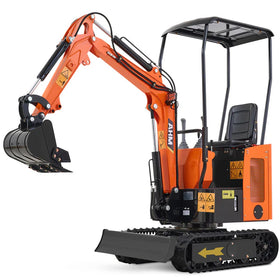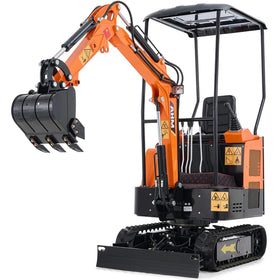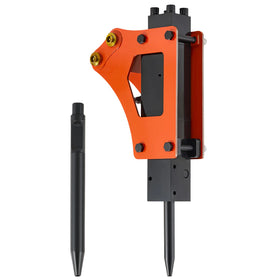Moving 500 pounds of tangled tree roots by hand takes three workers an hour of back-breaking labor.
Doing the same job with the wrong mini skid steer grapple also takes 45 minutes because the 24-inch jaw opening can't grip the load properly, and branches keep slipping through 9-inch tine spacing.
But switch to a properly sized 38-inch hydraulic root grapple with 3,000 PSI cylinder pressure and you'll be done in 15 minutes with zero manual labour.
Choosing the right mini skid steer grapple bucket will determine whether you complete your land clearing projects efficiently or waste hours repositioning loads that don't stay in place.
The specifications of the grapple you pick will directly impact what materials you can actually handle on your compact machine. Wondering what specs to look out for? We’ve got your back!

Choose the Right Skid Steer Grapple Type
Mini skid steer grapple attachments fall into three main categories based on tine design and the materials they can handle.
1. Root Grapples
Root grapples have flat, long bottom teeth with curved, serrated upper teeth designed to penetrate soil and grab buried items. The skeleton bottom design lets loose dirt fall through the 7-9 inch tine spacing while grabbing the roots, stumps, and logs.
Root grapples excel when you need to pull materials from the ground or handle debris mixed with soil. The wide tine spacing means smaller rocks and twigs fall through, but larger roots and logs stay secured.
- Tine spacing: 7-9 inches allows dirt to sift through
- Bottom jaw: Flat teeth for stability during loading
- Upper jaw: Curved, hooked teeth for gripping irregular shapes
- Opening: 24-39 inches, depending on model size
- Weight: 250-350 pounds for mini skid steer models
2. Rock Grapples
Rock grapples use narrower tine spacing (2-4 inches) with serrated cutting edges specifically designed to sift through dirt while retaining rocks and smaller debris. The tighter spacing keeps rocks from falling through during transport.
The tighter tine spacing on rock grapples makes them less effective for large logs or brush piles that would catch on every tine. Use rock grapples when you’re working with stone, broken concrete, or mixed demolition debris.
- Tine spacing: 2-4 inches for rock retention
- Serrated edges: Cuts through compacted material
- Reinforced construction: Handles heavy rock loads
- Opening: Similar to root grapples (30-42 inches)
- Bottom design: Open skeleton for dirt sifting
3. Pallet Fork Grapples
Pallet fork grapples combine standard pallet forks with hydraulic grapple jaws, creating a dual-purpose attachment for both palletized materials and loose debris. Pallet fork grapples cost 30-50% more than standard root or rock grapples but eliminate the need to switch attachments while working.
- Fork tines: Standard pallet fork configuration
- Grapple mechanism: Top jaw clamps down over forks
- Versatility: Handles both pallets and loose materials
- Construction: Heavier-duty for commercial applications
- Opening: Wide jaw

How to Choose the Right Mini Skid Steer Root Grapple
To select the correct grapple for a mini skid steer, match these five critical specs to your machine’s capacity and material type.
1. Match Grapple Width to Machine Capacity
Your mini skid steer's rated operating capacity (ROC) determines the maximum safe grapple size. The attachment weight reduces available lifting capacity for materials.
- Mini skid steers under 1,000 lbs ROC: 36-38 inch grapples (250-300 lb attachment weight)
- 1,000-1,500 lbs ROC: 38-42 inch grapples (300-350 lb attachment weight)
- 1,500-2,000 lbs ROC: 42-48 inch grapples (350-400 lb attachment weight)
2. Jaw Opening and Tine Spacing
Jaw opening determines the maximum size of materials you can grip, while the tine spacing controls what falls through versus what stays inside.
Manufacturers report that 7-9 inch tine spacing provides the optimal balance for land clearing operations - wide enough to let loose dirt fall through while retaining roots and branches effectively.
- 24-30 inches: Small brush, debris piles, rocks
- 30-36 inches: Medium logs (8-12 inch diameter), root balls
- 36-42 inches: Large logs (12-16 inch diameter), stumps
- 42+ inches: Commercial applications, multiple items per load
Tine spacing by material type:
- 2-4 inches: Rock grapples retain smaller stones
- 5-7 inches: General purpose, retains most debris
- 7-9 inches: Root grapples allow maximum dirt sifting
- 3/8 inch tine thickness: Standard applications
- 1/2 inch tine thickness: Heavy-duty commercial use
3. Hydraulic Cylinder Specifications
Hydraulic cylinder bore size and operating pressure will determine the gripping force and jaw reliability. Dual-cylinder grapples cost 20-30% more but provide superior grip strength on irregularly shaped loads. The independent cylinders adjust to uneven surfaces, maintaining secure holds where single cylinders would lose grip.
4. Construction Quality and Materials
Your grapple buckets’ longevity will depend on the steel grade, weld quality, and protective features.
- Steel grade: A36 (structural) minimum, A572 (high-strength)
- Plate thickness: 3/8 inch standard duty, 1/2 inch heavy duty
- Cylinder protection: Guards prevent damage from falling debris
- Hose routing: Protected paths reduce hydraulic failures
- Replaceable components: Teeth and wear surfaces should be bolt-on
- Greaseable fittings: All pivot points need lubrication access
5. Compatibility and Quick Attach Systems
Most mini skid steer grapples work with universal quick-attach systems compatible with Toro Dingo, Ditch Witch, Vermeer, AGT, and similar brands. Bobcat machines using MTL mounts require specific plate configurations - verify before ordering.

Recommended Mini Skid Steer Grapple Buckets from AHM
1. AHM 38-Inch Hydraulic Root Grapple - $1,559.99
The AHM 38-inch hydraulic root grapple delivers professional-grade capability for mini skid steer loaders. Built with a robust 37.8 x 30.5 x 23.4 inch grapple frame, this attachment handles everything from construction debris and brush to logs and root balls with secure gripping that prevents slippage on irregular surfaces.
- Grapple frame: 37.8 x 30.5 x 23.4 inches for substantial capacity
- Jaw opening: Wide grip to accommodate large and multiple items
- High-grade steel construction provides durability in demanding conditions
- Smooth cylinder action for precise control
- Universal mini skid steer mounting system
- Optimized jaw geometry prevents slippage
Compatibility: Works with most stand-on mini skid steers, including:
- AHM mini skid steer models
- CREWORKS equipment
- TYPHON STOMP machines
- AGT loaders
- Hengwang equipment
- Ditch Witch mini loaders
- Toro Dingo models
- Vermeer compact equipment
The Bottom Line
Choosing the best mini skid steer grapple bucket requires matching specs like the jaw opening, tine spacing, and hydraulic cylinder specifications to your machine's rated operating capacity and the materials you handle most frequently.
Root grapples with 7-9 inch spacing work best at land clearing and debris removal, rock grapples with 2-4 inch spacing handle stone sorting and demolition cleanup, and pallet fork grapples provide dual functionality for commercial operations.
The AHM 38-inch hydraulic root grapple at $1,559.99 delivers professional-grade performance with its 37.8 x 30.5 x 23.4 inch frame, universal compatibility across major mini skid steer brands, and quick-attach design for efficient task switching.
Verify your machine's ROC, select a grapple width that leaves enough lifting capacity for materials, and choose the correct tine spacing, and you’ll be off to the races!







